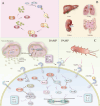Regulation of ubiquitination in sepsis: from PAMP versus DAMP to peripheral inflammation and cell death
- PMID: 39720715
- PMCID: PMC11666442
- DOI: 10.3389/fimmu.2024.1513206
Regulation of ubiquitination in sepsis: from PAMP versus DAMP to peripheral inflammation and cell death
Abstract
Sepsis (sepsis) is a systemic inflammatory response triggered by infection, and its pathologic features include overproduction of peripheral inflammatory factors (e.g., IL-1β, IL-6, TNF-α), which ultimately leads to cytokine storm and multiple organ dysfunction syndrome (MODS). Pathogen-associated molecular patterns (PAMP) and damage-associated molecular patterns (DAMP) induce strong immune responses and exacerbate inflammation by activating pattern recognition receptors (PRRs) in the host. Ubiquitination, as a key protein post-translational modification, dynamically regulates the activity of several inflammation-associated proteins (e.g., RIPK1, NLRP3) through the coordinated action of the E1, E2, and E3 enzymes, affects cell death pathways such as necroptosis and pyroptosis, and ultimately regulates the release of peripheral inflammatory factors. Deubiquitinating enzymes (DUBs), on the other hand, influence the intensity of the inflammatory response in sepsis by counter-regulating the ubiquitination process and balancing pro- and anti-inflammatory signals. This review focuses on how PAMP and DAMP activate inflammatory pathways via PRRs, and the central role of ubiquitination and deubiquitination in the development of sepsis, especially the mechanisms in regulating the secretion of peripheral inflammatory factors and cell death. By deeply dissecting the impact of the balance of ubiquitination and deubiquitination on inflammatory regulation, we further envision its potential as a therapeutic target in sepsis.
Keywords: DAMP; PAMP; necrotic apoptosis; peripheral inflammatory factors; sepsis; ubiquitination.
Copyright © 2024 Li, Yu, Zeng and Lin.
Conflict of interest statement
The authors declare that the research was conducted in the absence of any commercial or financial relationships that could be construed as a potential conflict of interest.
Figures
Similar articles
-
The role of damage- and pathogen-associated molecular patterns in inflammation-mediated vulnerability of atherosclerotic plaques.Can J Physiol Pharmacol. 2017 Oct;95(10):1245-1253. doi: 10.1139/cjpp-2016-0664. Epub 2017 Jul 26. Can J Physiol Pharmacol. 2017. PMID: 28746820 Review.
-
Microbial recognition and danger signals in sepsis and trauma.Biochim Biophys Acta Mol Basis Dis. 2017 Oct;1863(10 Pt B):2564-2573. doi: 10.1016/j.bbadis.2017.01.013. Epub 2017 Jan 20. Biochim Biophys Acta Mol Basis Dis. 2017. PMID: 28115287 Free PMC article. Review.
-
Toll-like receptors in sepsis-associated cytokine storm and their endogenous negative regulators as future immunomodulatory targets.Int Immunopharmacol. 2020 Dec;89(Pt B):107087. doi: 10.1016/j.intimp.2020.107087. Epub 2020 Oct 12. Int Immunopharmacol. 2020. PMID: 33075714 Free PMC article. Review.
-
Roles of PRR-Mediated Signaling Pathways in the Regulation of Oxidative Stress and Inflammatory Diseases.Int J Mol Sci. 2021 Jul 19;22(14):7688. doi: 10.3390/ijms22147688. Int J Mol Sci. 2021. PMID: 34299310 Free PMC article. Review.
-
Pathogen- and Danger-Associated Molecular Patterns and the Cytokine Response in Sepsis.Surg Infect (Larchmt). 2018 Feb/Mar;19(2):107-116. doi: 10.1089/sur.2017.264. Epub 2018 Jan 24. Surg Infect (Larchmt). 2018. PMID: 29364781 Review.
Cited by
-
PDE10A Inhibition Reduces NLRP3 Activation and Pyroptosis in Sepsis and Nerve Injury.Int J Mol Sci. 2025 May 8;26(10):4498. doi: 10.3390/ijms26104498. Int J Mol Sci. 2025. PMID: 40429643 Free PMC article.
-
Post-translational modifications orchestrate mTOR-driven cell death in cardiovascular disease.Front Cardiovasc Med. 2025 Jul 15;12:1620669. doi: 10.3389/fcvm.2025.1620669. eCollection 2025. Front Cardiovasc Med. 2025. PMID: 40734978 Free PMC article. Review.
References
Publication types
MeSH terms
Substances
LinkOut - more resources
Full Text Sources
Medical
Miscellaneous


